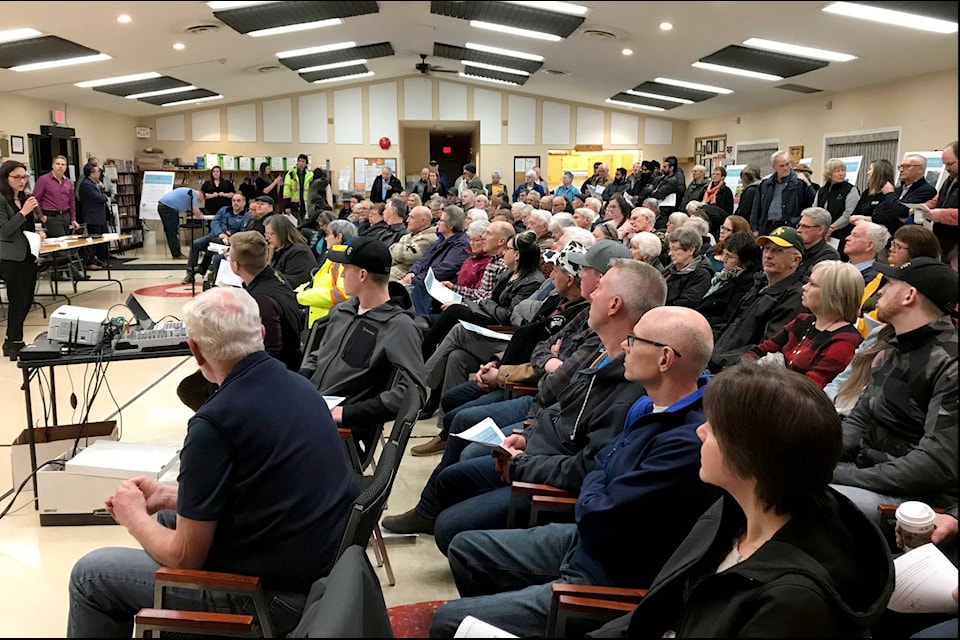It was a close, highly debated issue leading up to the 4-1 vote two weeks ago. The District of Kent’s council – sans Coun. Kerstin Schwichtenberg – voted to support an application to exclude the controversial Teacup properties from the Agricultural Land Reserve (ALR).
While the close vote indicates council was more or less unified in the effort to pursue developing the Teacup properties, the community was considerably more divided, if the recently released results of the district’s survey are any indication.
District officials presented the results during the May 25 meeting of the District Council. Past surveys conducted through The Observer indicated a heavy lean against the exclusion application, but the results based on the district’s survey indicated that out of 473 responses, a much closer 55 per cent were not in support of the exclusion application whereas 44 per cent were. The remaining one per cent was undecided.
RELATED: KAAC won’t back Kent’s Teacup properties plans
Other public engagement efforts
On February 27, the district initially presented a project page through the district’s website explaining the details of the most recent development proposals for the property. By the time survey results were collected, it garnered 512 unique page views. A notification sign was posted on McDonald road on the same day, per Agricultural Land Commission (ALC) rules. Also on the same day, district staff developed the survey, which is broken down in the three main sections: personal information, indication of support or disapproval and thoughts on the proposed development if everything is approved.
A community engagement meeting took place at the Friendship Centre in Agassiz on March 10. The packed house had moments of tension but was overall civil, hearing opinions from 28 of the 130 people who attended the meeting.
RELATED: Kent council votes 4-1 in favour of Teacup properties development
The survey: By the numbers
The survey closed on March 26.
In total, the district received 462 comment sheets. Eleven residents provided a verbal statement or a letter without submitting a formal comment sheet. About 90 per cent of participants resided within the district and 72 per cent lived within the Agassiz town site. Just over half of the participants were over the age of 55.
A large percentage of participants who identified as business owners were in support of the application; 80 per cent said yes. Curiously, 55 per cent of farmers were in support of the application with 45 per cent against it, a near complete reversal of the overall results. The results from participants under the age of 45 were split the same way – 55 per cent for, 45 per cent against.
Those who said they were residents of the district were 57 per cent against the application; the split among participants ages 45 and over is identical at a 57-43 per cent split.
Those who live on Mt. Woodside reported the lowest amount of support with only a 42.85 per cent approval rating. Rural agricultural support was at 53 per cent, and Rockwell Drive residents were in full, 100 per cent support.
The district further provided a graphic indicating levels of support throughout the Agassiz town site. Those who lived closest to the Teacup properties had the lowest levels of support with a 10.11 per cent approval rating. Those who lived between 250 and 500 metres and 751 to 1000 metres were fairly split at 48.39 per cent approval each. Those participants sandwiched in the middle between 501 and 750 metres away from the Teacup properties were 27.69 per cent. Those on the outskirts of the town site – those who live more than 1 kilometre from the Teacup properties – were most approving with 81.25 per cent supporting the application.
Comments in support of the exclusion application welcomed development without commercial zoning, acknowledging the limits of infilling without vertical growth. They were also in support of an increased tax base associated with new homes.
Comments submitted against the exclusion application advocated for the preservation of prime, class 1 agriculture land for food growth. The $3 million contribution to be included in the land deal is seen as a bribe by detractors, and there were further concerns about traffic, school district capacity, infrastructure integrity and the lack of support from the Kent Agricultural Advisory Committee.
Complete survey results are available through the District of Kent’s website, www.kentbc.ca.
What’s next?
The ultimate fate of the Teacup properties has been hotly contested for going on 25 years due in no small part to its importance to the future of the district of Kent, whether it is developed or not.
With the approval of the council, this application will eventually go to the ALC. The district has its work cut out for it as they will also need to prepare and approve a number of smaller projects, including a development plan, an amended Official Community Plan and development permits.
